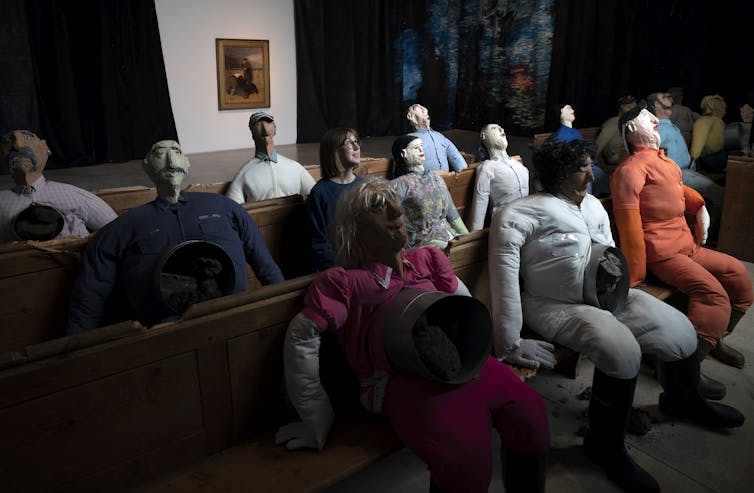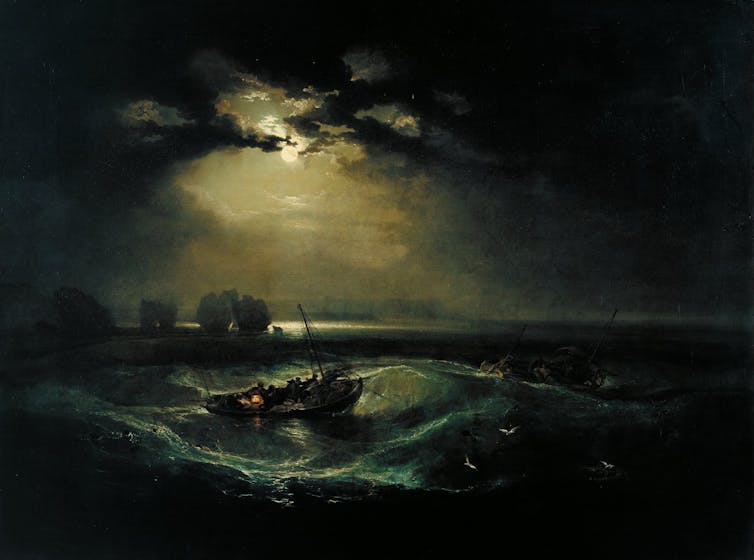
A member of gallery staff sits in one of 2019’s winning pieces called ‘Collective Conscience’ by artist Oscar Murillo.
Will Oliver/EPA
The chair of the Turner Prize jury, Alex Farquharson, surprised the art world when he announced that the 2020 prize will be replaced by ten bursaries of £10,000 each. This decision could signal a change in the way the British art world operates and a potential step towards a more diverse and equitable industry in the wake of the coronavirus pandemic.
Founded in 1984, the Turner Prize is one of the most prestigious awards on the UK art scene. Awarded annually to an artist who works primarily in Britain, or who was born in Britain and works overseas, the award has a major impact on the recipient’s career prospects. Celebrity artists Damien Hirst and Grayson Perry rank among the list of former winners, and Tracey Emin was catapulted into the media when her installation My Bed was among the nominees in 1999.
An award for contemporary art is bound to attract controversy, and the Turner Prize has received more than its share of criticism. While Prince Charles is reported to have asserted that the award had “contaminated” Britain’s art establishment, the art group known as the Stuckists suggested in 2000 that:
The only artist who wouldn’t be in danger of winning The Turner Prize is Turner.
Turner’s last wishes
Joseph Mallord William Turner would have been pleased to see a prize named in his honour. He was a generous artist, bequeathing over 300 paintings and thousands of sketches to the British nation upon his death in 1851. He also made a bequest to the Royal Academy of Arts in London and left a substantial cash sum in his will for the establishment of a hospital and almshouses for artists who had fallen on hard times. Yet Turner’s posthumous wishes were not fulfilled in the way the artist had hoped.

Joseph Mallord William Turner’s Fishermen at Sea, which he exhibited at the Royal Academy.
Wikimedia
His paintings were ultimately divided between the National Gallery and the Tate (now Tate Britain), the hospital was not built, and the support for so-called “decayed” artists did not materialise. Ironically, during the current pandemic, Turner’s hopes of supporting wider communities of artists may eventually be coming to fruition.
Of the £40,000 Turner Prize monies, the winner typically receives £25,000 and the three other shortlisted artists receive £5,000 each. In 2019, however, the four finalists – Lawrence Abu Hamdan, Helen Cammock, Oscar Murillo and Tai Shani – asked to be considered as a group in a gesture of “commonality, multiplicity and solidarity”. The prize monies were shared equally between them.
The Tate’s decision to award ten bursaries instead of giving the Turner Prize to an individual is an extension of this collective approach. The decision has been taken, in part, for practical reasons. The current situation is hardly conducive to physical art viewing and jury deliberations. But there may be something more to learn from this temporary suspension of the Turner Prize.
With social distancing policies in force, museums around the world have faced disruption and, at least, temporary closure. Major art fairs and biennials have been postponed and auctions seriously curtailed. The negative impact of these developments on artists’ exhibition prospects, opportunities, and livelihoods has been dramatic. It has forced many to consider what the art world will look like post-pandemic.
Art world for all
The art market has traditionally been a winner-take-all environment in which only a few artists command the highest prices. However, in the wake of the current crisis, it might be possible to realise a more diverse and democratic art sector.

Tai Shani, Helen Cammock, Oscar Murillo and Lawrence Abu Hamdan won the 2019 Turner Prize as a collective in what they called a ‘statement of solidarity’.
The unfolding history of the Turner Prize hints at this possibility. As artists themselves advocate for a collective approach to the award of prize monies and arts councils and institutions rethink the range of support they provide to individuals and groups, it is tempting to think that we’re witnessing the emergence of a more solidaristic creative economy. The upshot of this could benefit artists and their publics in various ways: a more diverse art world, wider funding options, enhanced institutional support for artists, less focus on celebrity. An increased number of smaller grants could offer a vital lifeline to artists in the early stages of their careers or encourage them to embark on riskier, innovative projects.
Turner’s portrait appears against the background of one of his most famous paintings, The Fighting Temeraire, on the current £20 British banknote. Nestled in the lower right-hand corner of the note is a copy of Turner’s signature as it appears on his will. As this year’s bursaries are handed over to ten artists instead of one, perhaps the British art world has drawn a little closer to Turner’s last wishes.
Kathryn Brown, Lecturer in Art History, Loughborough University
This article is republished from The Conversation under a Creative Commons license. Read the original article.